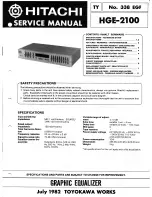
FDC can also be employed as a simple spectrum analyzer along with its primary use with the equal-
izer. This will allow you to identify “hot” spots – area of potential feedback – and attenuate accordingly
before feedback occurs. Of course, during a musical performance, FDC will help you quickly locate
and eliminate feedback if it occurs.
Be careful when running a sound system close to its feedback limit. Feedback can damage equip-
ment as well as hearing.
FDC SYSTEM PRECISION
The HQ EQ circuitry is extremely precise. The equalizer features Constant-Q Filtering, which helps
the HQ’s FDC work with great efficiency. When feedback occurs at a certain band, the ensuing
attenuation will not affect surrounding bands. This precision is, of course, critical for professional
applications.
INSTALLATION
These equalizers are designed for mounting in a standard 19” equipment rack or one of the many
rack type portable cases available on the market. The vertical height is 3.5 inches and depth is 7.5
inches.
POWER CONNECTORS
This series of graphic equalizers have internal power supplies and are designed for operation from
120 or 240 volt, 50-60Hz mains supply. Power consumption is 30 watts. In new installations and
portable sound systems, or any situation in which the mains power is in question, it is wise to confirm
the voltage and select the appropriate line voltage switch BEFORE connecting the equalizer to power
sources.
INPUT/OUTPUT CONNECTIONS
This series of graphic equalizers have 3 sets input output connectors wired in parallel: XLR, 1/4"
phone, and RCA phono connectors.
Only one of the 3 inputs should be used per channel. Any combination of output connectors may be
used.
XLR connections are balanced where pin 2 is High (+), pin 3 is Low (-), and pin 1 is ground.
3































